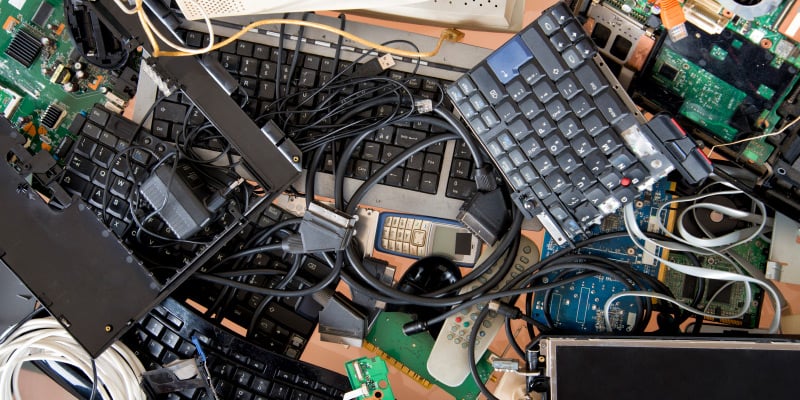How to Manage E-Waste Disposal Effectively
May 19, 2022

In our modern world, every business in every industry depends on electronic devices to function. PCs and laptops have become foundational tools for all employees, while equipment like printers, scanners, phones and displays are essential to operations.
Keeping that technology up to date is also critical if businesses want to maintain their competitive edge, making the replacement of out-of-date electronic devices on a regular basis a business imperative.
But businesses need a plan in place to dispose of electronic equipment effectively and safely once it reaches its end of life. Here’s what you need to know to manage your electronic waste responsibly.
Understanding Electronic Waste
Although phones, computers, monitors and related equipment make up a significant portion of electronic waste, “e-waste” as it’s also called, can come from almost any modern technological device. In a recent report, the United Nations found that electronic waste is one of the world’s fastest-growing waste streams, with the generation of e-waste expected to reach 74.7 megatons by 2030. If this electronic waste isn’t disposed of properly, materials like lead and mercury can leach into the soil and groundwater, making it hazardous to the environment and human health.
The Business Challenges of Electronic Waste
Businesses have a unique challenge when it comes to disposing of electronic waste. For them, the most common sources of e-waste include outdated PCs, servers and other data storage devices—items that are high-risk for a variety of reasons. If these devices aren’t disposed of properly, valuable business and consumer data could be accessible to anyone who recovers them. This makes the proper disposal of e-waste a cybersecurity issue as much as an environmental issue.
Not only do businesses need to protect their data, but they need to protect their bottom lines. Businesses that improperly dispose of e-waste run the risk of their old stock being recovered and illegally sold, expose themselves to civil and environmental lawsuits and invite penalizations from the state for a lack of compliance. Any of these happenings could impede business, or halt it entirely. What’s more, making unsavory headlines because of these possibilities can tarnish any brand and plant the seeds for far-reaching negative impacts.
The proper disposal of electronic waste is now also an essential part of meeting environmental, social and corporate governance (ESG) goals. The progress that companies make in reducing their environmental impact is carefully scrutinized by stockholders, the board, employees, vendors and the communities where the businesses operate. Many customers won’t work with a company that has poor ESG performance, making it a business imperative that you do everything you can to improve your metrics.
The Dos and Don’ts of Overcoming E-waste Complexity
Disposing of e-waste in a responsible, environmentally safe manner can be complicated if you’re not aware of the requirements and ramifications. Here are a few things to keep in mind when creating your e-waste disposal strategy:
-
- DON’T just send a hard drive off with data on it and hope for the best. Even if you reformat it before you dispose of it, data can still potentially be recovered. Make sure the device is wiped and/or physically dismantled and destroyed, with its components recycled, to ensure data protection. In some cases, materials should be destroyed entirely.
- DO work with a certified partner. There’s currently no federal e-waste law in place so policies and standards vary from state to state. To ensure compliance, especially if your business has multiple locations throughout the country, work with a partner that’s certified by e-Stewards and/or R2. This ensures your e-waste will be disposed of properly no matter the location.
- DON’T send your materials to a local scrap dealer—they don’t have the infrastructure necessary to properly recycle electronics. The best-case scenario is that they contract it out to an e-waste specialist, acting as a middleman and collecting a fee. The worst case is that they improperly dispose of the material, increasing your business risks.
- DO work with a reputable partner. Because regulations vary, almost anyone can call themselves an e-waste disposal specialist. However, an unscrupulous partner may end up dumping your materials in a landfill, selling your e-waste illegally or exporting it to a developing country where there isn’t proper e-waste recycling infrastructure. Make sure your e-waste disposal partner, along with their downstream partners, can provide full transparency into their process, including how they recycle, who they work with, their insurance coverage and their closure plan. A best-in-class partner will be one that does all their electronics shredding and processing on-site with round-the-clock monitoring, service certification and other secure destruction solutions, ensuring your waste gets properly managed.
- DON’T just send a hard drive off with data on it and hope for the best. Even if you reformat it before you dispose of it, data can still potentially be recovered. Make sure the device is wiped and/or physically dismantled and destroyed, with its components recycled, to ensure data protection. In some cases, materials should be destroyed entirely.
To meet your ESG goals and keep your employees, community, and business safe, a proper electronic waste recycling strategy is a must. The right e-waste partner will have a dedicated facility, a transparent process and a track record of success, giving you the confidence to know that your waste is being properly destroyed and recycled.
For more on e-waste recycling, visit our solutions page.